 |
| Category: Food |

|
|
|
|
|
- Who called the cook a
bastard?
- Who called the bastard a
cook?
|
- Why are the Catering
Corps called 'fitters and turners'?
- Because they fit good
food into dixies and turn it into shit.
|
|
7 May 1903
|
HMS
Dart complained to the Victualling
Officer at Sydney that salt beef issued to the ship had been in
brine since 1863 (40 years),
and that the ship’s biscuits were so hard they required boiling
for an hour before use. As a survey ship Dart received compensation
issues of coffee, tinned mutton and pickles. |
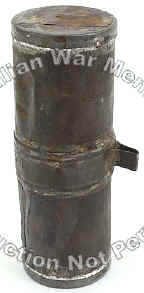 |
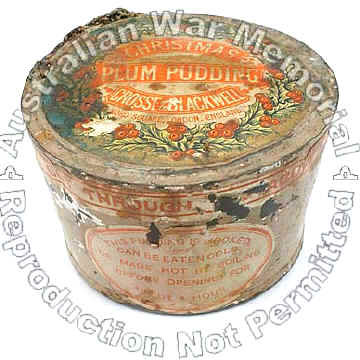 |
| Emergency ration
tins were first issued to troops during the Boer War and
contained either 8 ounces of bully beef or chocolate, or two
rations of 4 ounces each. |
Circular tin
containing a Christmas pudding. The manufacturer's labels are
on the top and sides of the tin with the maker's details and
serving instructions. The label on top is decorated with holly
wreath. This Christmas pudding was given to 106 Trooper Thomas
Ashford of 2 New South Wales Mounted Rifles during his service
in South Africa. |
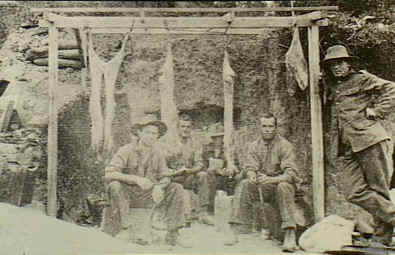 |
Informal
group of five cooks at the 5th Light Horse Brigade's B
Squadron cookhouse at Gallipoli. The cookhouse consists of an
uncovered wooden structure built into a mound of earth.
Hanging from the roof are four animal carcasses. Identified is
390 William Vesey Dawson (later DCM), B Troop, B Squadron, 5th
Light Horse, left, holding a knife and sharpening steel.
AWM P02023.005 |
|
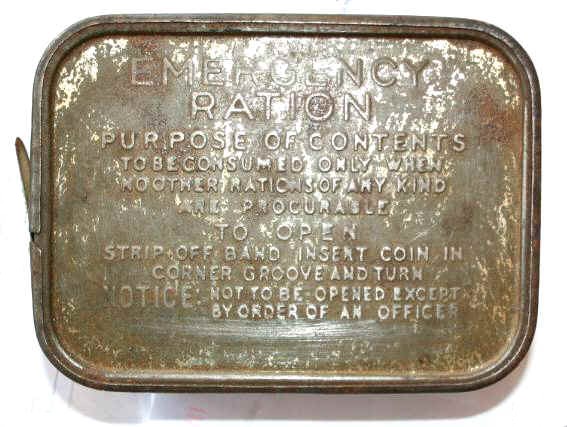
|
| WW1
Emergency Ration. "Purpose of
contents. To be consumed only when no other rations of any kind are
procurable' To open strip off band and insert coin in corner groove and
turn. NOTICE: Not to be opened except by order of an
officer". |
Lance-Corporal
J.J. Palmer of Anzac wanted to share these recipes with the
folks back home. They were printed in the Inglewood
Advertiser, 19/10/1915:
He wrote: Just a couple of recipes which have been tried in
Gallipoli with great success. Somebody might care to waste the
stuff in their spare time:-
Dug-out Porridge. Ingredients
- Two meal biscuits, large size (commonly known as dog
biscuits); one mess tin half-full of water. Treatment - Break
biscuits to powder; put mess tin with water on fire. When
boiling add powder and then stir for a while; then flavor with
milk and sugar, if available, otherwise jam marmalade,
plentiful.
French Rissoles. Ingredients
- One tin of bully-beef, any brand; little bit of biscuit
powder; a couple of onions and a little bit of thyme to
flavor. This grows plentifully about the hills. No need to add
salt, as the bully contains too much. Treatment - Chop up
onions very small and mix the lot together; have it just a bit
sticky. Make into small pasties and roll in flour, if one is
lucky enough to pinch some off the beach without getting
pinched himself. Fry well in lid of mess tin. To get fat for
same render down bacon from breakfast which was too fat to
eat. |
 |
Mafeking,
South Africa, C. 1900. Butchered
horses hanging from a tree ready to be handed out as rations
in the town during the siege. (Donor C. Booth) Note...all
the dogs in the town were also butchered and eaten. Times
were tough, but the Garrison survived and was eventually
relieved. Some Australians were in the besieged town and
others were in the relief party. |
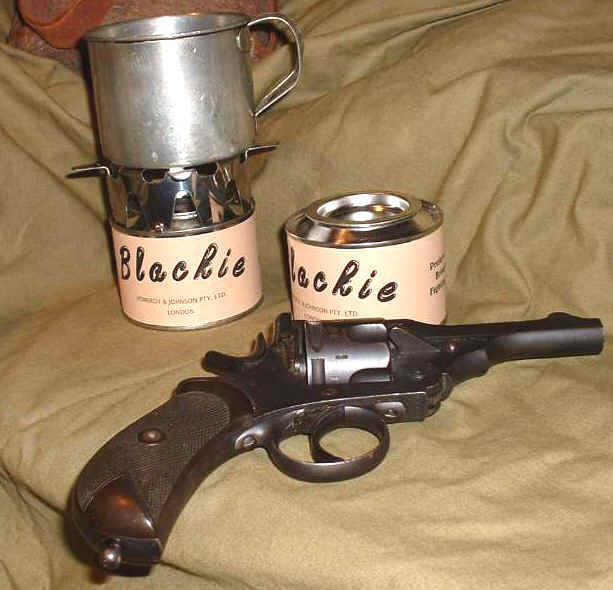 |
| The
"Tommy Cooker" was a small tin of jellied fuel
with a clip on metal attachment that acted as a stove. After
boiling the water or heating the food, just replacing the
tight fitting lid on the tin extinguished the flame and
allowed the balance of the fuel to be used at another time. |
 |
Cooks
of the 58th Battalion
with their field cooker
(mobile kitchen) at Dickebusch, near Ypres, where the 5th
Australian Division rested after the Third Battle of Ypres.
Identified, left to right: 2334 Private (Pte) P N Bennett;
3520 Pte A Findlay; 3251 T W Stanard; 3712 Pte B Crowl
(standing foreground); 4649 Pte G R Wythe; 1688 Pte F A
Greaves. |
 |
Rear
view of a field cooker as used by the first AIF |
 |
Australian
soldiers cooking their dinner in the support
line trenches, somewhere in France.
(Taken by the British Official
Photographer)
|
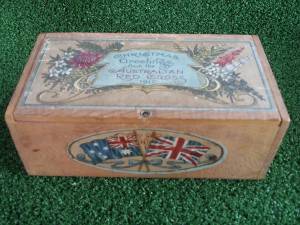 |
- 1917 Christmas parcel
sent to the troops by Australian Red Cross.
|
  |
|
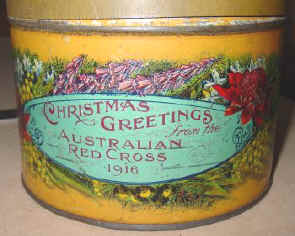 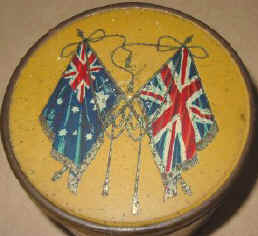
|
| Tinned
Christmas cake delivered to the troops by Red Cross, 1916 |
|
WW2 Red
Cross Food Parcel for
Prisoners of War
Food parcels
usually contained the following: Tea, cocoa, sugar,
chocolate, oatmeal, biscuits, sardines, dried fruit,
condensed milk, jam, corned beef, margarine,
cigarettes/tobacco, and soap.
|
 |
31.5cm
long x 19cm wide x 13cm deep: Received by VX4688
Private R Glanville of 2/7 Infantry Battalion in 1943, while
he was a prisoner of war in Silesia (then in Prussia, but
now a part of Poland). He later cut the out the base of the
box that that it could hold a short wave radio that he had
made.
|
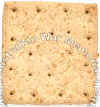 |
Arnott's
hard tack biscuit as
issued to the Australian Army during World War Two. These
biscuits were exceptionally hard and difficult to eat unless
soaked in liquid or broken up with several blows of a
bayonet handle. They were, however, good nutritional value.
Along with 'bully beef' which was a tinned lightly corned
beef mixture they formed the base of the infantryman's diet. |
 This
is what one Digger thought of them This
is what one Digger thought of them |
 |
Tobruk,
Libya. 1941-08. Representatives of the
2/48th infantry battalion receiving an issue of canteen
stores from the army canteen services store. Even in the
front line the weekly ration service was maintained. |
 |
Nuseirat,
Palestine. 1942-11-05
Base units of the A.I.F. (Middle East) have been instructed
to grow their own vegetables. The Sergeants' Mess of No. 1
Australian Convalescent Depot planted their ration of dried
peas. To everyone's surprise, they sprouted like seed peas
and as seen by this picture a good crop should be harvested. |
 |
| 1943-05-11. New
Guinea. Milne Bay. Army
stockmen with sheep at slaughter yards at Milne Bay. (Negative by N. Brown). |
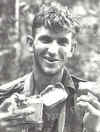 |
Papua,
New Guinea. 1942-10.
Private P. Shimmin of the 2/33rd Australian Infantry
Battalion starts on his daily ration of bully beef straight
out of the tin.
Bully, biscuits and water was all the men
had for three days.
|
|
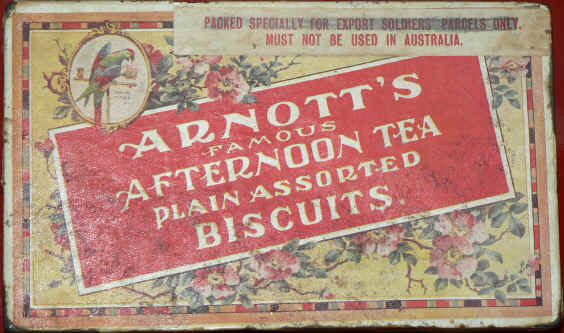
|
|
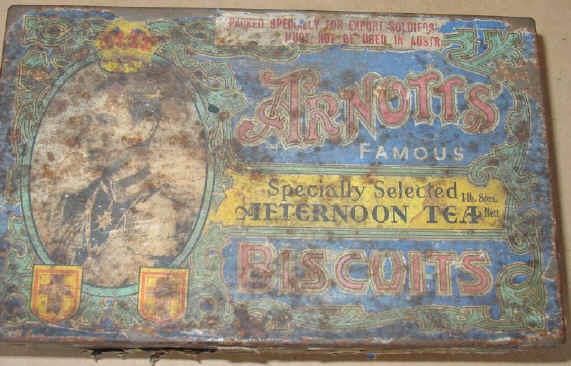
|
| Arnotts'
Specially Selected Afternoon Tea biscuits. 1lb 8 ozs.
Marked "Packed specially for export soldiers. Must not
be used in Australia". |
 |
Ramu
Valley, New Guinea, 1943-10-03. Chimbu
and Bena native carriers arriving at the 2/7th Australian
Independent headquarters, with medical stores and rations,
from Kainantu. |
 |
Guy's
Post, Faria River area, New Guinea. 1943-11-08. Troops
of the 2/33rd Australian Infantry Battalion examining the
new field operational ration. This ration contains three
meals, each wrapped separately. Shown are, left to right:
NX41189 Corporal C. J. Smith; NX12806 Lance Corporal W. D.
Fletcher; NX51052 Private H. L. Pilkington. |
|

|
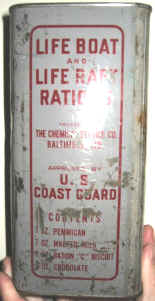 |
| Rations
were issued as "Emergency Rations" and were
designed to be eaten only in the case of nothing else being
available |
Life
boat and life raft ration packs (US manufacture). |
 |
Papua,
New Guinea. 1942-10. Members of
the 2/27th Australian infantry battalion as they reached the
outpost at Itiki, after being out
of touch with other troops for 13 days. They had had very
little food and were in bad
shape when they came in. |
 |
1942-03-09.
Australian women join the army.
Cooks provide army meals in camps and barracks. AWAS cooks
boiling puddings. (negative by E. Cranstone).
|
 |
Yaula,
New Guinea. 1944-04-09.
VX108667 Sergeant J.
Blomley, 57/60th Infantry Battalion, prepares scones for
baking using an oven improvised from abandoned Japanese
petrol drums packed with earth. It
is said of Blomley that he was a thief, but was forgiven as
he only ever stole ( he called it acquired) food and only
for his troops, never himself. A side of bacon here, a few
kilos of butter there, it all helps. |
 |
Dumpu,
New Guinea. 1944-02-05.
VX139868 Corporal R.H.
Page (1) of the 24th Infantry Battalion and VX144966 Private
J. Stewart (2) of the 57/60th Infantry Battalion, pictured
in the bread room of the 15th Infantry Brigade bakery. |
 |
Dumpu,
Ramu Valley, New Guinea.
1944-02-11. VX84574
Warrant Officer 1, R.A.H. Millard (1); Regimental Sergeant
Major, 57/60th Infantry Battalion sampling a fritter made by
the cooks of "B" Company. With him is VX139872
Private W.D. McNicoll (2). |
 |
Singapore,
Straits Settlements, 1945-09-10. Cpl
J. Bunning, Australian Army Service Corps, 8th Aust Division
(1) and Sapper C.F. Graham, 2/10 Field Company, Royal
Australian Engineers (2), 8th Australian Division,
ex-prisoners of war of the Japanese preparing Ikan Tukau, a
large Malayan fish, the first good fish to be included in
the ex-prisoners of war's rations. |
 |
June
1944. Ration books for
food and clothing. Rationing of clothing for civilians in
Australia began in June 1942 and food rationing followed. |
 |
Lutong,
Borneo, 5 July 1945. Fifteen
Indian prisoners of war of the Japanese escaped into the
jungle of 10 June 1945 and reached Australian forward
positions at Miri on 28 June 1945. Fourteen of the men are
members of 17 Field Company Royal Bombay Sappers and Miners,
Indian Army Engineers and one member of 10/6 Punjab
Regiment. The men were captured by the Japanese in Singapore
and brought to Lutong. Shown above, Lieutenant C Cook, B
Company, 2/13 Infantry Battalion issuing rations to Naik
(Cpl) Surat Singh.
|
|
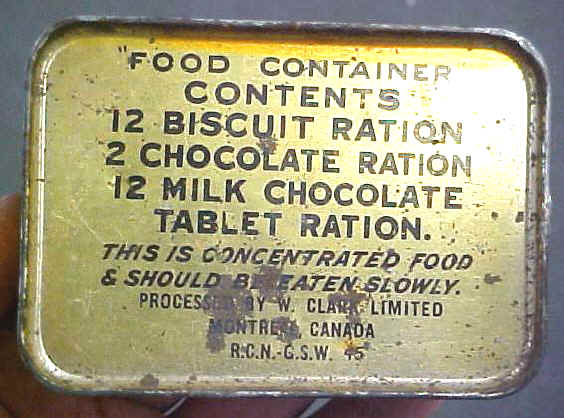
|
|
A Canadian emergency
ration pack as used by some Aussie airmen. |
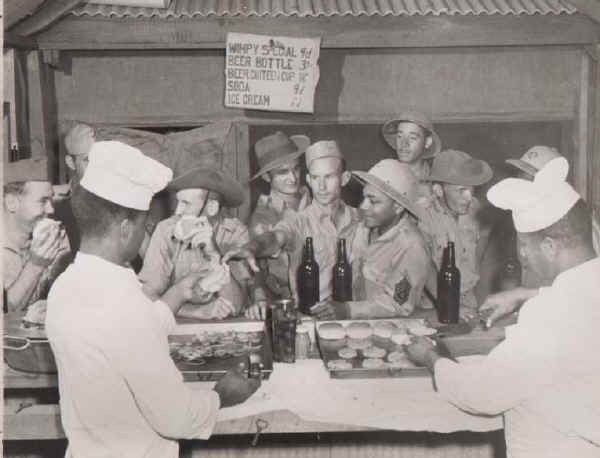 |
| Diggers & Doughboys
share a meal of the new fangled (to Australians) food called Hamburgers.
Note the price list. Note that beer was available. This photo was taken
in Australia during WW2. |
|















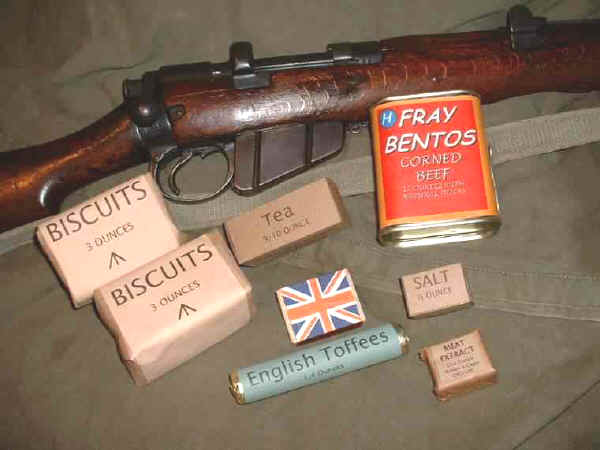
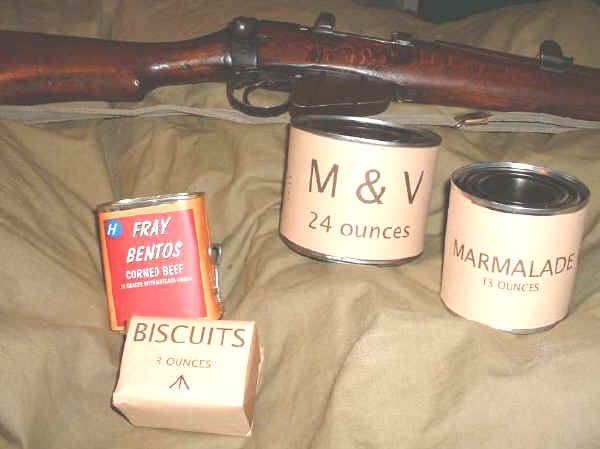









 This
is what one Digger thought of them
This
is what one Digger thought of them
















